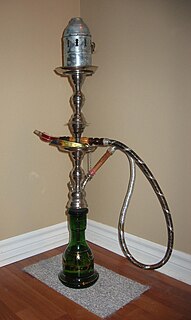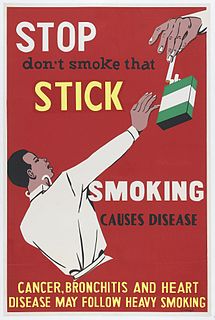Related Research Articles

The Public Health Cigarette Smoking Act is a 1970 federal law in the United States designed to limit the practice of tobacco smoking. As approved by the United States Congress and signed into law by President Richard Nixon, the act required a stronger health warning on cigarette packages, saying "Warning: The Surgeon General Has Determined that Cigarette Smoking Is Dangerous to Your Health". It also banned cigarette advertisements on American radio and television.

The Federal Cigarette Labeling and Advertising Act is a comprehensive act designed to provide a set of national standards for cigarette packaging in the United States. It was amended by the Public Health Cigarette Smoking Act of 1969, Comprehensive Smoking Education Act of 1986, and the Family Smoking Prevention and Tobacco Control Act of 2009. It came in conflict with California Proposition 65.

The smoking age is the minimum legal age required to purchase or use tobacco products. Most countries have laws that forbid sale of tobacco products to persons younger than certain ages, usually the age of majority.

Tobacco politics refers to the politics surrounding the use and distribution of tobacco.

The Family Smoking Prevention and Tobacco Control Act, is a federal statute in the United States that was signed into law by President Barack Obama on June 22, 2009. The Act gives the Food and Drug Administration the power to regulate the tobacco industry. A signature element of the law imposes new warnings and labels on tobacco packaging and their advertisements, with the goal of discouraging minors and young adults from smoking. The Act also bans flavored cigarettes, places limits on the advertising of tobacco products to minors and requires tobacco companies to seek FDA approval for new tobacco products.

Regulation of tobacco by the U.S. Food and Drug Administration began in 2009 with the passage of the Family Smoking Prevention and Tobacco Control Act by the United States Congress. With this statute, the Food and Drug Administration (FDA) was given the ability to regulate tobacco products.

The use of tobacco products in Egypt is widespread. It is estimated that approximately twenty percent of the population uses tobacco products daily. Cigarettes are the most common form of tobacco consumption in Egypt, with an estimated twenty billion cigarettes smoked annually in the country. After cigarettes, shisha water-pipes are the most common form of tobacco consumption. Many Egyptians are not fully aware of the health risks of using a water-pipe and many believe it to be less harmful than cigarettes.

SmokinginCanada is banned in indoor public spaces, public transit facilities and workplaces, by all territories and provinces, and by the federal government. As of 2010, legislation banning smoking within each of these jurisdictions is mostly consistent, despite the separate development of legislation by each jurisdiction. Notable variations between the jurisdictions include: whether, and in what circumstances ventilated smoking rooms are permitted; whether, and up to what distance away from a building is smoking banned outside of a building; and, whether smoking is banned in private vehicles occupied by children.

Smoking in Nigeria is prohibited in public places and is punishable by a fine of not less than N200 and not exceeding N1000 or to imprisonment to a term of not less than one month and not exceeding two years or to both a fine and imprisonment.
Smoking in Ireland is banned fully in the general workplace, enclosed public places, restaurants, bars, education facilities, healthcare facilities and public transport. However, it is permitted in designated hotel rooms and there is no ban in residential care, prisons and in outdoor areas. Public opinion is in favour of the bans on smoking imposed in Ireland.

In Finland, the smoking figures are among the lowest in Europe. There are several factors that have influenced the decrease in the smoking prevalence, such as legislative actions, health promotion and national monitoring systems, policies aimed at reducing tobacco consumption through public awareness campaigns, advertising bans and increased taxation. Ministry of Social Affairs and Health has the leading role in tobacco control in Finland, and one of their main aims is have a more effective ban on sale of tobacco products to children and young people and to prevent sale of illegal tobacco products. Among the key elements in the successful tobacco policy is the traditional collaboration between the health authorities and non-governmental organisations, and intensive health promotion.

Smoking in Iceland is banned in restaurants, cafés, bars and night clubs as of June 2007. A large majority of Icelanders approve of the ban. At the time the ban went into effect, almost one in four Icelandic people were smokers.
The Tobacco Control Act of Bhutan was enacted by the Parliament of Bhutan on 6 June 2010 and came into force on 16 June. It regulates tobacco and tobacco products, banning the cultivation, harvesting, production, and sale of tobacco and tobacco products in Bhutan. The act also mandates that the government of Bhutan provide counselling and treatment to facilitate tobacco cessation. Premised on the physical health and well being of the Bhutanese people – important elements of Gross National Happiness – the Tobacco Control Act recognizes the harmful effects of tobacco consumption and exposure to tobacco smoke on both spiritual and social health.
Regulation of electronic cigarettes varies across countries and states, ranging from no regulation to banning them entirely. For instance, e-cigarettes were illegal in Japan, which forced the market to use heat-not-burn tobacco products for cigarette alternatives. Others have introduced strict restrictions and some have licensed devices as medicines such as in the UK. However, as of February 2018, there is no e-cigarette device that has been given a medical license that is commercially sold or available by prescription in the UK. As of 2015, around two thirds of major nations have regulated e-cigarettes in some way. Because of the potential relationship with tobacco laws and medical drug policies, e-cigarette legislation is being debated in many countries. The companies that make e-cigarettes have been pushing for laws that support their interests. In 2016 the US Department of Transportation banned the use of e-cigarettes on commercial flights. This regulation applies to all flights to and from the US. In 2018, the Royal College of Physicians asked that a balance is found in regulations over e-cigarettes that ensure product safety while encouraging smokers to use them instead of tobacco, as well as keep an eye on any effects contrary to the control agencies for tobacco.

Tobacco Policy in Armenia is the attempt by the Armenian authorities to regulate smoking in Armenia. Tobacco laws and regulations are controlled by the Ministry of Health of Armenia. Armenian men tend to be the most common tobacco users, as 42.5% of men over the age of 15 smoke.

As nicotine is highly addictive, marketing nicotine-containing products is regulated in most jurisdictions. Regulations include bans and regulation of certain types of advertising, and requirements for counter-advertising of facts generally not included in ads. Regulation is circumvented using less-regulated media, such as Facebook, less-regulated nicotine delivery products, such as e-cigarettes, and less-regulated ad types, such as industry ads which claim to discourage nicotine addiction but seem, according to independent studies, to promote teen nicotine use.

Tobacco smoking among South Africans is quite a customary practice, but, in recent years, the percentage of smokers has decreased. This is largely due to the increase in the precaution of the dangers of smoking and enforcement of stricter legislation on the tobacco industry. In 1996, the provinces with the highest percentage and prevalence of smoking include Northern Cape (55%), Western Cape (48%) and North-West (46%). However, the number of smokers still remains stagnant. Despite the efforts to bring awareness to the risks that come with smoking, there is still a high prevalence of tobacco use in South Africa; and it is a major contributor to morbidity and mortality.

The minimum purchase age for tobacco in the United States before 2019 varied by state and territory. Since December 2019, the smoking age in all states and territories is 21 after federal law was passed in Congress and signed by President Donald Trump in December 2019.
References
- ↑ South Africa's Winning Tobacco Control Strategy
- ↑ Tobacco Products Control Act 1993
- ↑ multinationalmonitor.org; The Great South African Smokeout, Anna White, 2001]
- ↑ polity.org.za; Madlala-Routledge: Tobacco Products Control Amendment Bill (29/03/2007)]
- ↑ https://www.gov.za/sites/default/files/31790_23.pdf [ dead link ]